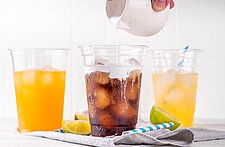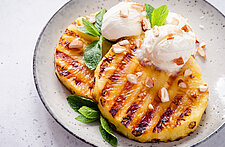If the Starchefs International Chefs Congress (ICC) theme Cooking With Respect: Better Ingredients, Better Food had anything to say about it, the future of food is good to be about utilizing every scrap of an ingredient so that no flavor is left behind.
 In their mainstage demonstration, How to Build a Zero-Waste Pantry, Austin’s Emmer & Rye chefs Kevin Fink, Page Pressley, and Tavel Bristol-Joseph detailed how their dedication to a zero-waste kitchen contributes to their overall success. Respecting whole ingredients, they use various processes of aging, curing, dehydrating, and pickling so to preserve every part of every ingredient that comes in, therefore never having to take inventory or stress storage space. Utilizing scraps helps them stay creative and come up with unique flavor combinations, too.
In their mainstage demonstration, How to Build a Zero-Waste Pantry, Austin’s Emmer & Rye chefs Kevin Fink, Page Pressley, and Tavel Bristol-Joseph detailed how their dedication to a zero-waste kitchen contributes to their overall success. Respecting whole ingredients, they use various processes of aging, curing, dehydrating, and pickling so to preserve every part of every ingredient that comes in, therefore never having to take inventory or stress storage space. Utilizing scraps helps them stay creative and come up with unique flavor combinations, too.
Read More From StarChefs 2018 ICC: Fermented, Foul & Funky
For those newly attempting a zero-waste concept, Fink advised to first look at their kitchen’s excess: an Italian restaurant making pasta inevitably has an abundance of egg white lying around, he used as an example. Then, find two other excess waste products that can realistically be worked together over the long term to creative a unique, flavor-forward food product regularly reducing kitchen waste.
With ingredients assembled, the next step is to figure out which method will transform scrap to center plate. “Do I need to texture this better? Do I need to remove the bitterness from that? Do I want to make it sourer?” he said. “Will it work with direct salt brining, mold growth, sugar fermentation, or yeast fermentation? Would it be a good vinegar? If you poached it under water, would it remove the bitterness? If you held it under fat, would it keep?”
Pressley added that long-term vision helps them concentrate and carry flavor from one season to the next. Last year, a seared broccoli dish with sweet-and-sour notes was one of their highest sellers. But seared off before service, a few orders were inevitably left behind every night. Preserved in a high-salt lactic acid brine, those scraps will now bring even more flavor to the same dish this year. “It takes a little time, it takes a little patience, and it takes a lot of maintenance,” he said. “But the unique flavor you should be able to express through processes and techniques like that are well worth the time and attention.”
RELATED: Balance, Bright Flavors & Sustainability Are All On Chef Alison Trent's Menu
Lactic acid brine gets used and reused for other purposes, of course. Of the pickled cherry bomb peppers brought to the demo Pressley said, “It's a pickled pepper and everyone loves that—it's a beautiful thing. But one of the great parts about the brine is that you can use it to flavor sauce or even do secondary fermentation, to carry a season's flavor into another season with a different conduit of ingredients.” Also contributing to zero-waste sauces were scraps from mushrooms, various forms of miso and fermented vegetable broths, and old bread toasted and then pureed with such broths.
When it comes to sweet applications, pastry chef Bristol-Joseph’s panna cotta with parsnips scraps exemplified both the zero-waste concept and the vegetable-forward dessert trend also seen regularly throughout the Congress. Dehydrating the parsnip scraps brought out their sugar content and vanilla notes. Those then contrasted an almost strawberry-sweet fermented tomato jam, and granola made from leftover bran.
 “I’m not trying to be healthy,” Bristol-Joseph said of his desserts, which regularly incorporate savory ingredients with sweet. His popular fermented black garlic ice cream pulls notes of licorice and almond, which he then pairs with poached honeycomb. On his brunch menu, a “superfood cupcake” utilizes whatever vegetables scraps the kitchen has on hand – kale, carrot tops, beet greens, etc. – in a red velvet cake-like sponge he then tops with cultured cream and a grating of local Texas cheese similar to parmesan. “It’s something special and made all of byproducts—I don’t have to buy anything,” he said.
“I’m not trying to be healthy,” Bristol-Joseph said of his desserts, which regularly incorporate savory ingredients with sweet. His popular fermented black garlic ice cream pulls notes of licorice and almond, which he then pairs with poached honeycomb. On his brunch menu, a “superfood cupcake” utilizes whatever vegetables scraps the kitchen has on hand – kale, carrot tops, beet greens, etc. – in a red velvet cake-like sponge he then tops with cultured cream and a grating of local Texas cheese similar to parmesan. “It’s something special and made all of byproducts—I don’t have to buy anything,” he said.
The goal is always about indulgence. “Anytime I'm going to make something, I want to make sure that I'm in love with it and people can indulge in it and there's no compromise,” he said. Incorporating unexpected, concentrated flavors from scraps normally tossed into the rubbish bin? They just help achieve that goal.
Want to receive the latest food & drink trends to your inbox? CLICK HERE!





